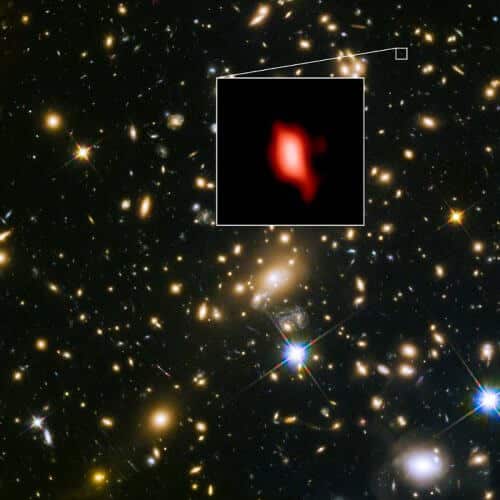An international team of astronomers using ALMA to observe a distant galaxy called MACS1149-JD1 also discovered the most distant concentration of oxygen ever detected in the universe. Alma is operated by the European Space Agency's European Southern Observatory (ESO).

Astronomers used observations from the Atacama Large Millimeter/Subillimeter Array (ALMA) and ESO's Very Large Telescope (VLT) to determine that star formation in the very distant galaxy MACS1149-JD1 began unexpectedly early, just 250 million years after the Big Bang . With the same observation, the most distant oxygen ever detected in the universe was also discovered, as well as the most distant galaxy ever observed by 'Alma' or the VLT.
They detected a very faint glow emitted by ionized oxygen in a distant galaxy. As this infrared light traversed space, the expansion of the universe stretched its wavelength by more than 10 times until it reached Earth and was detected by Alma. The team concluded that the signal was emitted 13.3 billion years ago (or 500 million years after the Big Bang), making it the most distant concentration of oxygen detected by any telescope. The presence of oxygen is a clear sign that this element was present even in the first generations of stars in this galaxy.
"I was very excited to discover the signal indicating the existence of a distant oxygen concentration as observed in the 'Alma' data," says Takuya Hashimoto, the lead author of the scientific paper that came out following this discovery and a researcher at Osaka Sangyo University and the National Astronomical Observatory of Japan. "This detection further pushes the boundaries of the observable universe."
In addition to the oxygen-derived glow observed by Alma, a weaker signal of hydrogen emission was also detected in the same galaxy. This discovery was made using ESO's Very Large Telescope (VLT). The distance to the galaxy determined from this observation is consistent with the distance found in the oxygen observation. This makes MACS1149-JD1 the most distant galaxy whose distance has been accurately measured and the most distant galaxy ever observed by ALMA or the VLT.
"This galaxy was seen at a time when the universe was only 500 million years old, yet it already has a population of mature stars," explains Nicolas Laporte, a researcher at University College London (UCL) in the United Kingdom and the second author of the paper. "Therefore we can use this galaxy to study the earliest period of cosmic history."
During the time after the big bang there was no oxygen in the universe; It was created in the fusion processes of the first stars and then released when those stars died. The detection of oxygen in MACS1149-JD1 indicates that these previous generations of stars were already forming and distributing oxygen only 500 million years after the beginning of the universe.
But when did the early stars form? To find out, the team reconstructed MACS1149-JD1's past history using infrared light data collected by the Hubble Space Telescope and the Spitzer Space Telescope. They found that the observed brightness of the galaxy is well explained by a model in which the onset of star formation occurred only 250 million years after the universe formed.
The maturity of the stars seen in MACS1149-JD1 raises the question of when the first galaxies emerged from total darkness, a period astronomers call the "cosmic dawn." By discovering the age of MACS1149-JD1, the team effectively proved that galaxies existed earlier than those we can currently detect directly.
Richard Ellis, a senior astronomer at UCL and another author of the paper, concludes: "Destination of cosmic dawn is the closest thing to the holy grail of cosmology and galaxy formation. With these new observations of MACS1149-JD1 we are approaching direct evidence of the birth of the starlight that created the materials that make us up, and are in fact our origins.”
to the announcement of the European Space Agency
More of the topic in Hayadan:

4 תגובות
Nice article
Comfortable
You shouldn't be surprised. Those who manage these studies are mainly smart people who have reached their position thanks to their intellectual abilities.
Those who manage our lives are mainly selfish people who were elected to their positions by no less selfish people.
What is amazing about humanity is that they manage to understand when the universe and the stars were created, send people to the moon and maybe to Mars in crazy spaceships that they build, but to solve problems here on earth such as poverty and social gaps that are completely solvable with a little good will - up to here... it is big on us. delusional
Terminology note: not testimony but evidence